Menus
- MP3 killer? 5 day trial…
- Xmax Blu-Core single cylinder, UBS full braking, 14 "wheels, Bridgestone tires, Smart Key, tilt lock…
- Discovery
- In the saddle
- Contact
- In the city
- On the highway
- On small roads
- Braking
- Comfort / Duo
- Convenient
- Consumption
- The Tricity test in video
- Conclusion
MP3 killer? 5 day trial…
Xmax Blu-Core single cylinder, UBS full braking, 14 "wheels, Bridgestone tires, Smart Key, tilt lock…
How to give confidence to a two-wheeler driver? By adding a wheel! And thanks to adapted legislation allowing a B license with 7 hours of driving to drive a larger displacement than a 125, the concept has become a reality, offering more powerful (or less sluggish) urban mobility vehicles accessible to all, without needing to pass the permit. The success of the three-wheeler comes from there, initiated by Piaggio with the MP3, declined in all the displacements and invading all the cities. This has led to an annual European market of more than 20,000 three-wheelers … with this particularity of French legislation resulting in half of this market in France. This is enough to give desire to other manufacturers to seek this market, without ever equaling the success of Piaggio. Neither Peugeot with its Metropolis nor Quadro with the Qooder have indeed really succeeded in breaking through. And then, a Japanese manufacturer arrived, offering the Tricity 125 in 2014, at a time when the MP3 125 did not convince many people. Why settle for a 125 for a heavier three-wheeler when you can have a larger displacement without another license and for a price barely higher? The misfortune of one making the happiness of the other, the Tricity 125 has seized the market of three wheels 125 with more than 17,500 sales with a lighter and more dynamic proposition. Yamaha naturally did not stop there, offering the Niken in 2018 (on the bottom of the MT-09, to try) as well as a 3CT concept. The manufacturer with tuning forks continues in its lineage of three wheels with the Tricity 300 … enough to also fuel the rumors of a future three-wheel version of 500 cm3. So what to do better than Peugeot and Quadro and really compete with MP3 where others have failed ?
 A statutory and elegant three-wheeled scooter
A statutory and elegant three-wheeled scooter
Discovery
A three-wheeler can be recognized by its front axle, generally massive and heavy, topped with a grille. The Tricity 300 is in this line, even if the axle appears conversely lighter than the grille, thus displaying a sportier line and an exterior template closer to a 500 than to a 300, clearly borrowing from the little brother 125 with some elements of big brother Niken. For those who want a scooter that imposes it, they will be delighted. And then, from experience, a 300 is better than a 500. I’ve been saying this for years. A three is lighter, more agile, with a top speed just under a 500 and much cheaper. And when I say cheaper, it’s often around 3,000 euros, a real difference for what remains an urban mobility device, which must above all be practical and useful. There, we have a little butter and the money of butter, with a 300 which looks like a 500 but for the price of a 300.
 style in line with the Tricity 125
style in line with the Tricity 125
LED lighting both front and rear displays a nice light signature.
The light aspect of the double axle front axle comes from the technological choice with a double Cantilever telescopic fork on each wheel with parallelogram linkage, of the type of the Tricty 125 and the Niken, with suspensions installed inside the wheels. The whole thing is equipped with a version of the Ackermann steering system which optimizes the angle of each front wheel in relation to the rear wheel when cornering..
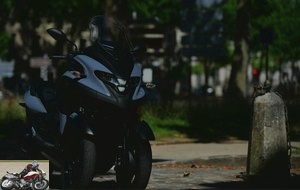 Ackerman steering and stationary assistance system
Ackerman steering and stationary assistance system
With the Tricity, Yamaha reuses proven technologies and in particular the basis of the XMax family, two-wheel scooters. The Tricity inherits in fact directly from the 292 cm3 Blu-Core 4T single cylinder engine of the XMax 300 with some modifications of injections and settings delivering 28 hp (2 hp more than an MP3 300 HPE), CVT transmission, with combined braking UBS (front and rear come into action together with the brake pedal or the left lever) but also a TCS traction control, 14 inch wheels shod with Brigestone tires and a 267mm disc on each wheel.
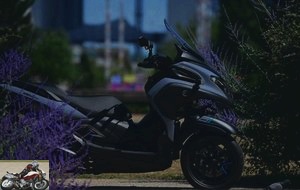 292 cc single cylinder
292 cc single cylinder
And there is also a keyless starting system. And above all, under the saddle, we find the same capacity as the XMax 300, with a 43.5-liter trunk enough to store two helmets. And above all, a scooter should be practical.
But it is the finish that is really there, as always at Yamaha, with quality plastics and clean fittings at all levels. Afterwards, you have to like this very trendy but a little sad concrete gray. There is also a khaki and a matte gray … but no black.
 LED light with small cover plate
LED light with small cover plate
In the saddle
it moves ! here pitching! Is there a technical problem? No. It is even a major point of differentiation with both the Tricity 125 and the MP3. The management is not frozen at a standstill but offers a little latitude but we will come back to it.
The saddle is high! And yet not that much at 795mm, but it’s wide like many scooters, so the d1.70 driver will barely put his feet on the ground. This is where the steering lock makes sense, since you can stop without dismounting and start in the same way..
 Keyless start and opening of the saddle on the apron
Keyless start and opening of the saddle on the apron
We then find the standard Yamaha comodos with in particular this large central button on the apron which allows to open the saddle or the gas hatch, a saddle with its small interior light. So as soon as you leave it open for a minute, a beep reminds you that you must close it. It is so annoying besides that you will not risk forgetting it.
In front of you, we have a large LCD screen with all the information: speedometer, tachometer, fuel gauge, clock, partial double trip, traction control indicator, consumption … There is a practical selector to scroll through the information and an essential warning easy to activate.
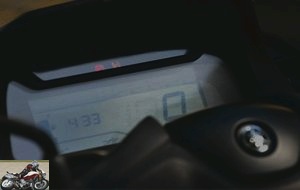 Instrument panel with full LCD display
Instrument panel with full LCD display
Compared to the XMax, on the other hand, there is a parking brake on the left, compulsory for category 3 three-wheel L5e.
The position is very straight, but compared to other scooters the knees go up a bit more. And the brake pedal is finally well thought out and well placed, which allows to have all the necessary space on the right for the feet, not to mention that as on the TMax the feet can also be placed forward..
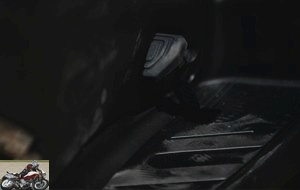 A well-thought-out, well-placed brake pedal that doesn’t get in the way
A well-thought-out, well-placed brake pedal that doesn’t get in the way
Finally, the mirrors offer excellent rearview.
Contact
The single cylinder snorts gently. A solicitation of the right handle and the steering automatically unlocks, allowing to rewind. The front axle appears both lighter and more natural than an MP3 at low speed, accompanying the driving a little more and at the same time, falling less under the weight, probably also because of the 50/50 weight distribution. front / rear of the scooter. The first turns of the wheels are natural, even if we do not find the peps of the Xmax 300. It must be said that despite the weight of "only" 239 kilos (all full), the Tricity still weighs 60 kilos more than the XMax 300 and 14 kilos more than the latest MP3 300 HPE.
 Easy to use with a front axle that is lighter than the competition
Easy to use with a front axle that is lighter than the competition
In the city
The 300 is clearly heavier than the 125, logically, but also than the XMax 300 … resulting in less dynamics at the green light, like the majority of three wheels. This is still more than enough to get out of the flow of traffic, but could frustrate a user of an XMax 300. Afterwards, the “Standing Assist” fixed station assistance system is easy to use and proves to be more secure than that of the MP3. Why ? Because with MP3 the steering and tilt are locked automatically. And we often use the system before we are completely shut down. It is enough then to be a little on the angle and not entirely in line, to see the direction blocking, the sidewalk approaching and the fall approaching. Nothing like this here, since even if we are a little on the angle, the tilt is flexible and not fully blocked (the calipers block the tilt mechanism but not the suspensions which remain free) and we can therefore recover a maneuver. which would not pass with an MP3.
 Maneuverability and easy tilt that gives you confidence
Maneuverability and easy tilt that gives you confidence
Because yes, we can start the system in freewheeling mode, shortly before arriving at a traffic light in particular. In fact, it accepts to lock under 10 km / h, if the engine speed is under 2,000 rpm and provided that the throttle grip is released. Many conditions but which allow to activate it and to continue to roll several meters, enough with an MP3 to put in the pile if one is not used to it. Here, we can recover the blow more easily. But you shouldn’t overdo it anyway! And to get started, you just need to speed up. In short, with the Tricity, you can never set foot in town. And it is rather practical on a daily basis.
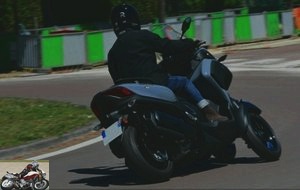 Easy tilt
Easy tilt
On the highway
The Tricity 300 engages dynamically on the motorway, stalling quickly at 120 km / h to then gain a few kilometers hours until going to tease the 145 km / h. This is clearly its strong point against the MP3 300, less dynamic and slower..
The bubble effectively deflects the wind at this speed while the stability is perfect. Even big curves are easily taken on the angle without worry or erratic heading. On the contrary, the Tricity confirms its stability at all speeds.
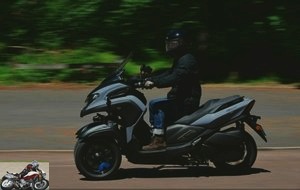 20.6 kW – 28 hp at 7.250 rpm
20.6 kW – 28 hp at 7.250 rpm
On small roads
The Tricity naturally finds the small roads on which it fits naturally. It continues to absorb pavement defects well without suffering from pavement defects on the corner. Driving remains safe including on the angle, angle which can be relatively large and which thus allows to chain the virolos without however having the liveliness of an XMax 300. The front axle is clearly more pleasant than its competitor MP3 and allows in particular to accelerate the pace much more clearly, both in terms of engine, stability and assurance provided by the front axle.
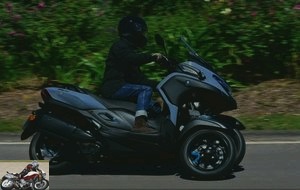 29 Nm at 5.750 rpm
29 Nm at 5.750 rpm
The times are there, at all speeds, even once again, if we do not have the liveliness of an XMax 300.
Braking
The foot brake pedal never gets in the way, but suddenly, at first we look for it to be able to use it. Once found, the foot braking is not too brutal and remains reassuring. But on a daily basis, we will pass on the use of the levers only, with the braking combined with the left lever and the front brake with the right lever..
Braking improves with the kilometers. It must be said that our test model was barely broken in and it was felt. The attack is soft and the braking rather gentle, even if it is more than sufficient in everyday life, but do not hesitate to take the levers with full hand..
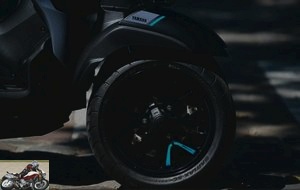 Hydraulically operated 267 mm discs on each wheel, ABS and UBS coupled system
Hydraulically operated 267 mm discs on each wheel, ABS and UBS coupled system
Comfort / Duo
Yamaha announced comfort and there is a giant leap made by the manufacturer, compared to the XMax 300 which is very dry. We now find ourselves at the same level of comfort as an MP3.
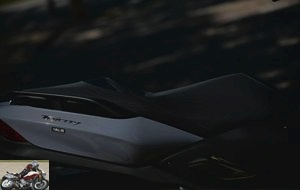 Saddle not very high at 795 mm but wide
Saddle not very high at 795 mm but wide
Convenient
Like the XMax 300, you can store two helmets under the saddle and this is really a strong point for a scooter that is above all practical. There is suddenly more storage space than an MP3 300.
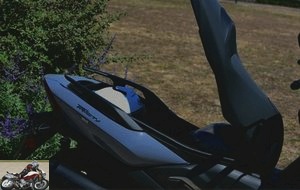 Space for two modular helmets and a small bag
Space for two modular helmets and a small bag
There is a cigarette lighter socket on the front, not very well placed but above all no USB socket as it is generalized to directly connect a smartphone? And there is no storage compartment either.
Note that despite the LCD screen, there is no mobile application, even if the interest of a mobile application is not a point justifying a purchase on its own.
We note the presence of a side stand in addition to the central.
And thanks to the steering lock, you can very well stop it in front of the garage and then gently push it inside with ease and ease..
Consumption
Yamaha announces a consumption of 3.3 liters per hundred. In fact, the gauge goes down very slowly, even if the actual consumption is more of the order of 3.7 liters per hundred, which offers nearly 350 kilometers of autonomy with the 13-liter tank (i.e. about 70 km more than ” an MP3, in particular thanks to a larger tank of two liters).
The Tricity test in video
Conclusion
Yamaha has renewed the success of its Tricity 125 with a Tricity 300, statutory, with a dynamic, comfortable, pleasant, fuel-efficient engine, with real storage capacity under the boot and a stationary assistance system that is easier than the MP3. It remains its price at 7,990 euros, 2,000 euros more than the standard version of the XMax 300, 1,500 euros more expensive than the competitor MP3 300 HPE (6,490 euros) and almost at the same price as the 350 which it approaches in terms of performance. motorization.
Strong points
- motor
- template
- trunk capacity
- axle
- braking
- drink
Weak points
- price
- no USB socket
The Tricity 300 technical sheet
Test conditions
- Itinerary: small varied roads + interurban highways with a bit of town
- Motorcycle mileage: 300 km
Related articles
-
Yamaha Xmax 300 Iron Max scooter test
Unlimited version of the tuning fork maxiscoot Leather, seat with backrest, aluminum footrest, specific color… A scooter is always worth less than the…
-
3 cylinders, 847 cm3, 115 hp, 8.9 m / kg, 195 kilos, € 12,599 A limited series of 695 pieces in collaboration with Abarth October 2007: Valentino Rossi…
-
Yamaha Tricity and Nmax scooter comparison
Yamaha upgrades its Urban Mobility scooter offer to Euro 4 standard Common BlueCore engine on these two models In life, there are existential questions:…
-
The three-wheeler at a low price Three-wheeled scooters have experienced tremendous growth, especially in France since the appearance of the Piaggio MP3…
-
A tri-wheeler called pleasure Three cylinders, 4T, 84.6 kW (115.0 hp), 87.5 N.m (8.9 m.kgf), 263 kg, 14,999 euros With the arrival in 2006 of the MP3…
-
2015 vintage Thirteen years since the TMax made its appearance with several major evolutions since the TMax 500 cm3. If the maxi scooter evolves again in…
-
Alone in the world Single cylinder VVA of 124 cm3, 15 hp and 11.5 Nm, 140 kg full made, 4,599 euros Today, when you want to ride a vintage / retro /…
-
Single cylinder, 292 cm3, 28 hp at 7,250 rpm, 29 Nm at 5,750 rpm, 179 kilos, € 5,899 Yamaha’s mid-size scooter gets a makeover and gets traction control…
-
Immediate pleasure ! Twin-cylinder CP2 of 689 cm3, 74.8 hp and 68 Nm, 188 kg full made, 8,799 € Halfway between a small compact roadster and a scrambler,…
-
The bête noire of conformism 3 cylinders in line, 889 cm3, 119 hp and 93 Nm, 189 kg, 9,499 euros With its MT-09, Yamaha revolutionized the market for…
Hello,
For clarification, the 1621-4 standard did exist, adopted by all European countries EXCEPT France..
Since this summer, it has been applied uniformly throughout ALL of Europe, … even in France, the French objection having been rejected.